1 Meet Apache Airflow
Enterprises increasingly depend on timely, high‑quality data, and rising data volumes make disciplined orchestration essential. This chapter introduces data pipelines and frames Apache Airflow as an orchestrator that coordinates work across systems—ingesting data, transforming it, training models, and publishing results—to produce reliable outcomes. It sets expectations for a hands‑on, production‑oriented journey: you’ll learn core concepts through practical examples, evaluate whether Airflow fits your context, and take first steps toward building maintainable pipelines.
The narrative builds from first principles: pipelines are collections of tasks with explicit dependencies best represented as directed acyclic graphs. DAGs make order clear, prevent deadlocks, and enable a simple scheduling algorithm that identifies runnable tasks and exploits parallelism (for example, processing independent data sets at the same time). Compared with monolithic scripts, graph‑based workflows improve resilience and efficiency by isolating failures and rerunning only affected tasks. The chapter then situates Airflow among workflow managers, noting that tools differ in how workflows are defined (code vs. static specifications) and in auxiliary features like scheduling, monitoring, and user interfaces, so selecting the right tool depends on your needs.
Airflow’s value proposition is detailed next: define pipelines as code (primarily Python) with the flexibility to generate tasks dynamically; integrate broadly through a rich provider ecosystem; and schedule DAGs using expressive time semantics. Its core components parse DAGs, decide what to run and when, execute tasks in parallel, and surface status and logs through a web UI. Built‑in retries, easy reruns, incremental processing, and backfilling support robust, cost‑efficient data operations. Airflow is a strong fit for batch and event‑triggered workflows, time‑bucketed processing, and teams that apply software engineering practices; it’s less suitable for real‑time streaming or teams seeking purely graphical, low‑code tools. The chapter closes by outlining the book’s path from fundamentals to advanced patterns and deployment, preparing you to run Airflow effectively in production.
For this weather dashboard, weather data is fetched from an external API and fed into a dynamic dashboard.

Graph representation of the data pipeline for the weather dashboard. Nodes represent tasks and directed edges represent dependencies between tasks (with an edge pointing from task 1 to task 2, indicating that task 1 needs to be run before task 2).

Cycles in graphs prevent task execution due to circular dependencies. In acyclic graphs (top), there is a clear path to execute the three different tasks. However, in cyclic graphs (bottom), there is no longer a clear execution path due to the interdependency between tasks 2 and 3.
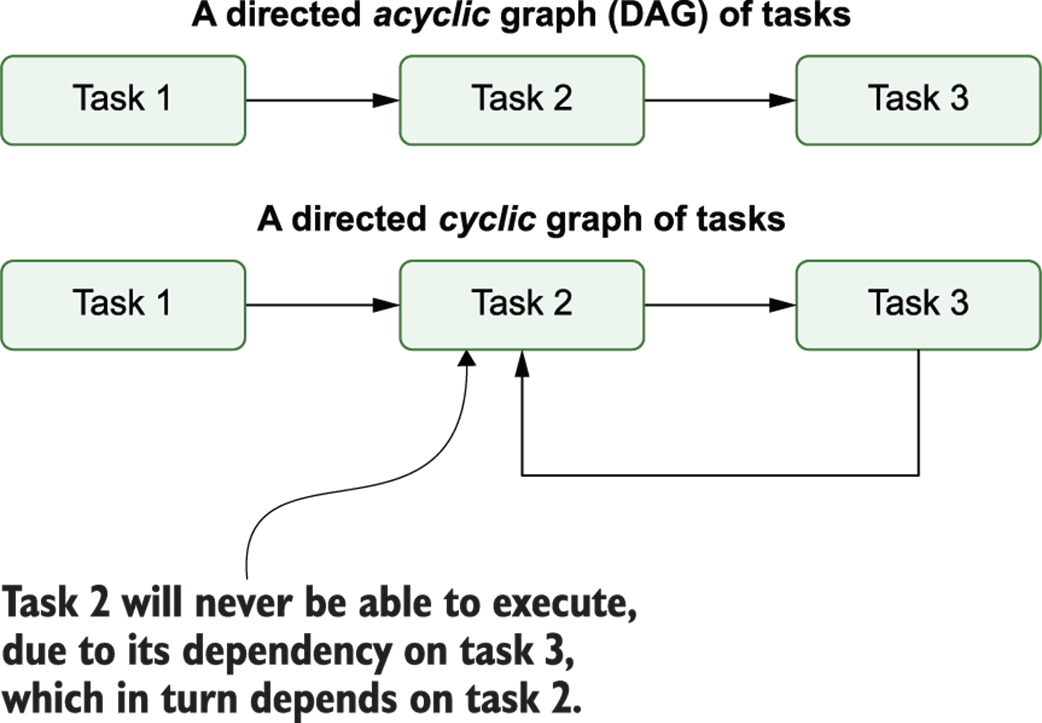
Using the DAG structure to execute tasks in the data pipeline in the correct order: depicts each task’s state during each of the loops through the algorithm, demonstrating how this leads to the completed execution of the pipeline (end state)
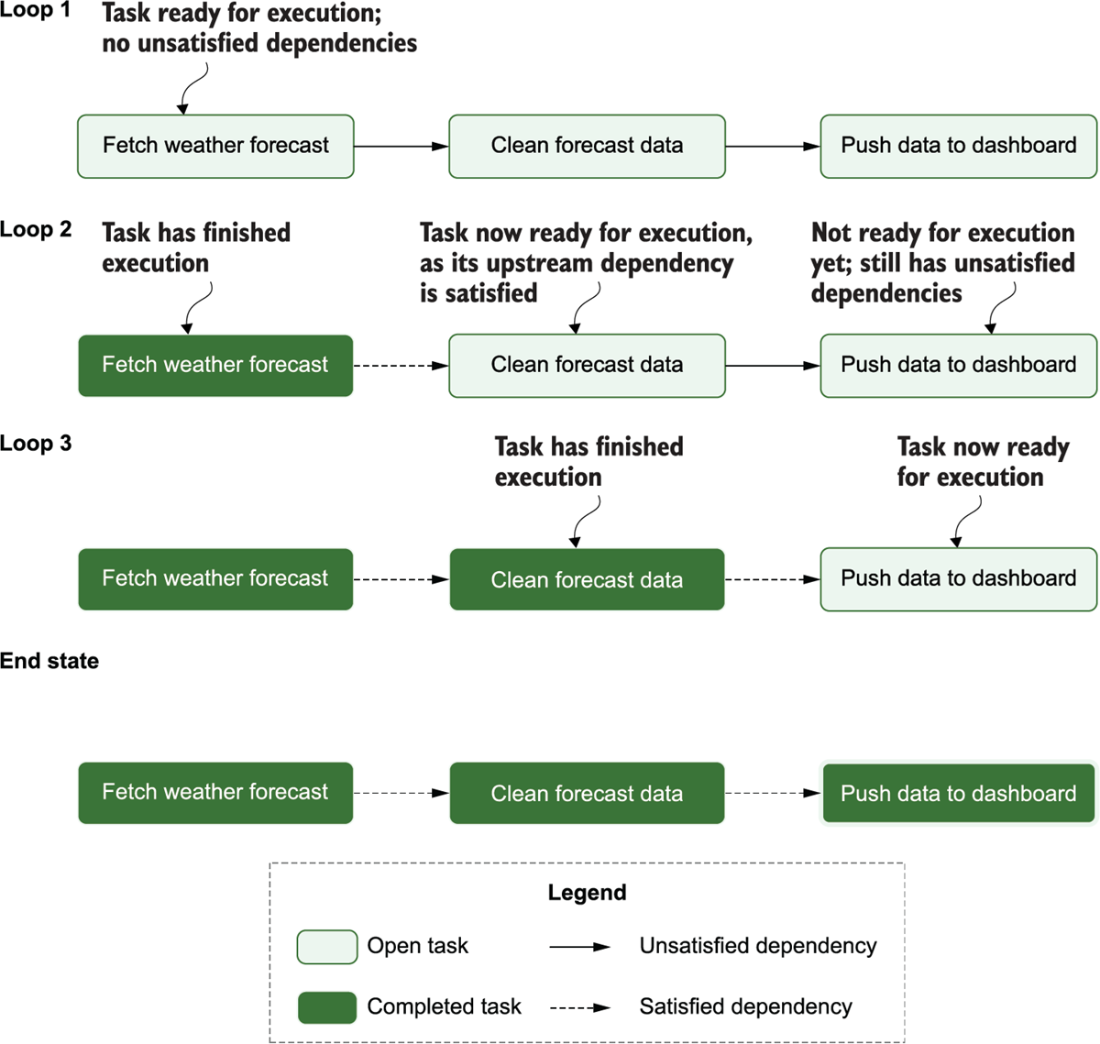
Overview of the umbrella demand use case, in which historical weather and sales data are used to train a model that predicts future sales demands depending on weather forecasts
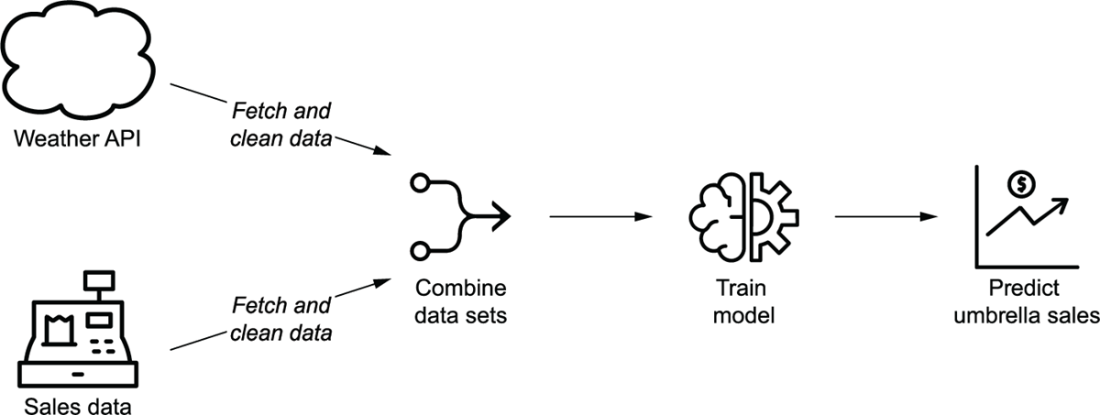
Independence between sales and weather tasks in the graph representation of the data pipeline for the umbrella demand forecast model. The two sets of fetch/cleaning tasks are independent as they involve two different data sets (the weather and sales data sets). This independence is indicated by the lack of edges between the two sets of tasks.

Airflow pipelines are defined as DAGs using Python code in DAG files. Each DAG file typically defines one DAG, which describes the different tasks and their dependencies. Besides this, the DAG also defines a schedule interval that determines when the DAG is executed by Airflow.
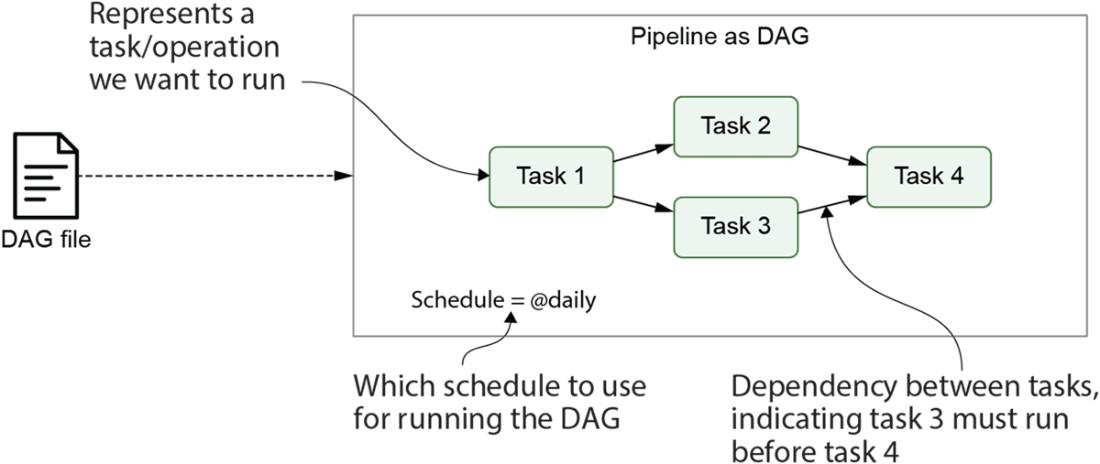
The main components involved in Airflow are the Airflow API server, scheduler, DAG processor, triggerer and workers.

Developing and executing pipelines as DAGs using Airflow. Once the user has written the DAG, the DAG Processor and scheduler ensure that the DAG is run at the right moment. The user can monitor progress and output while the DAG is running at all times.
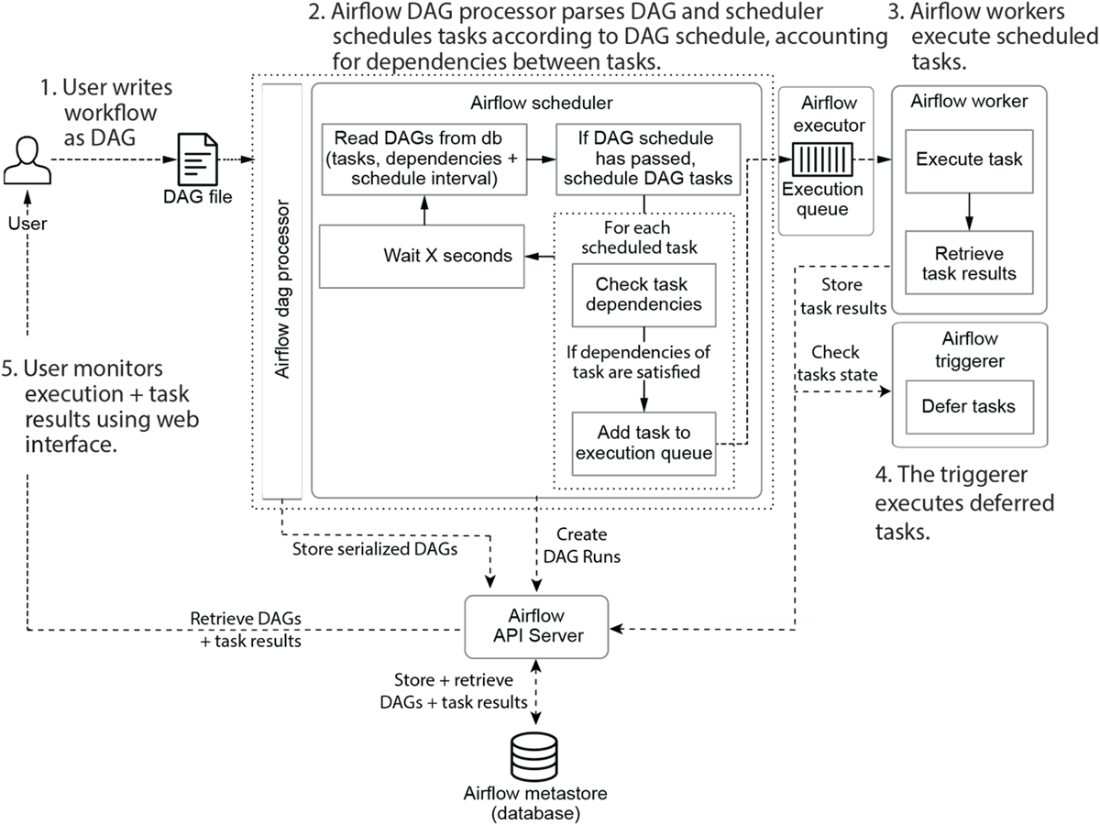
The login page for the Airflow web interface. In the code examples accompanying this book, a default user “airflow” is provided with the password “airflow”.

The main page of Airflow’s web interface, showing a high-level overview of all DAGs and their recent results.
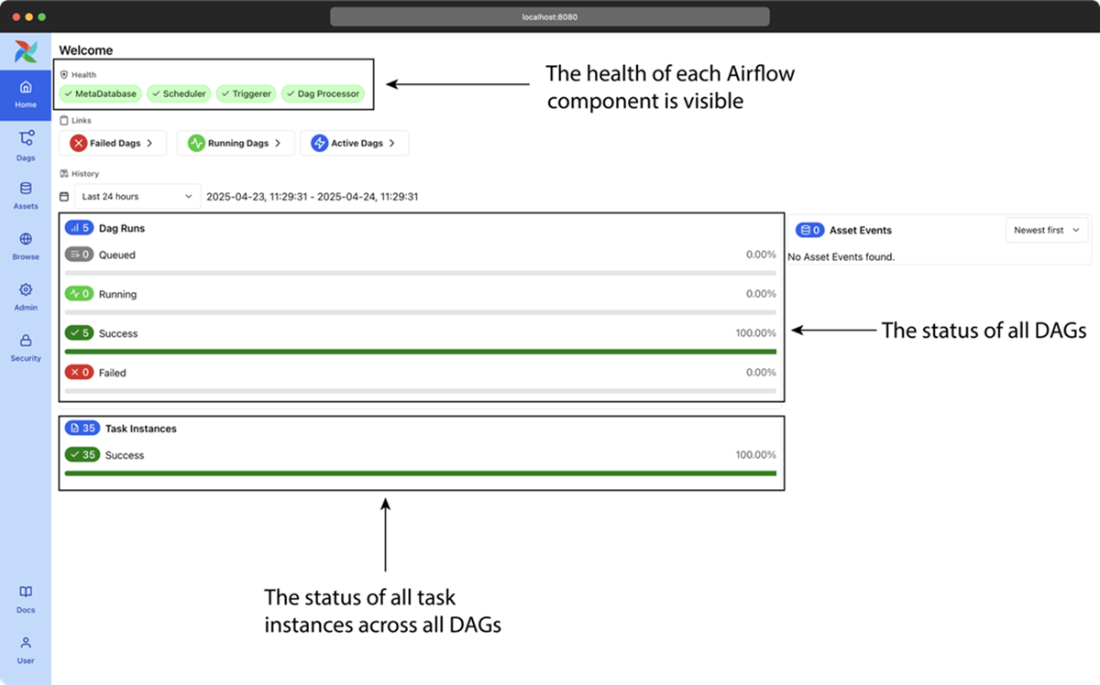
The DAGs page of Airflow’s web interface, showing a high-level overview of all DAGs and their recent results.

The graph view in Airflow’s web interface, showing an overview of the tasks in an individual DAG and the dependencies between these tasks
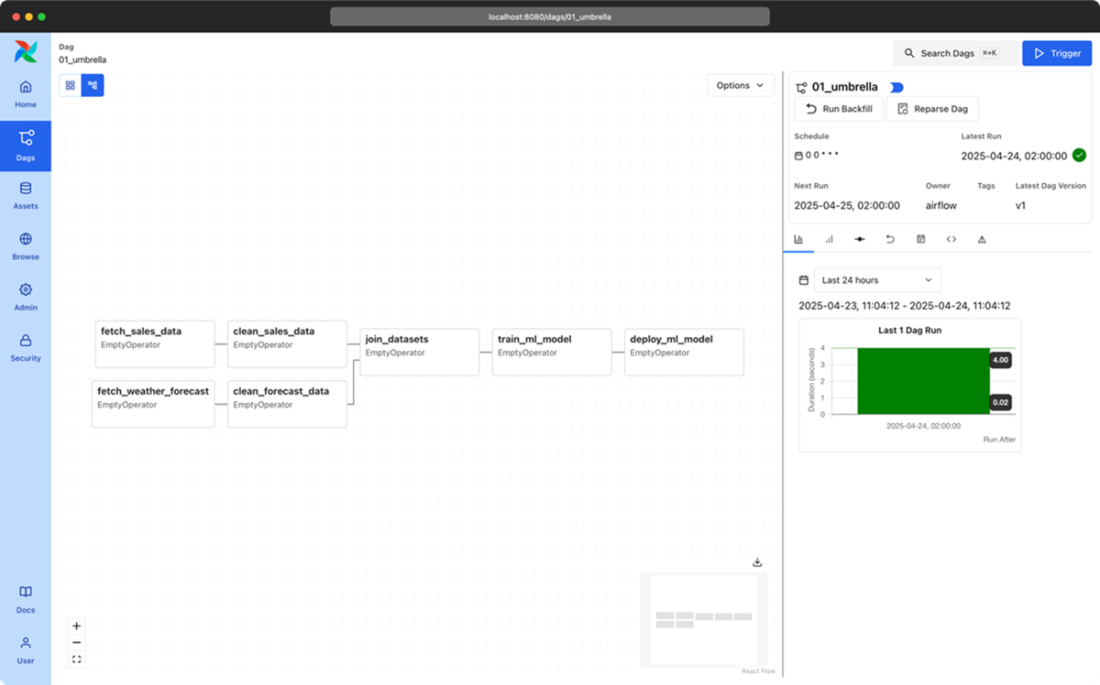
Airflow’s grid view, showing the results of multiple runs of the umbrella sales model DAG (most recent + historical runs). The columns show the status of one execution of the DAG and the rows show the status of all executions of a single task. Colors (which you can see in the e-book version) indicate the result of the corresponding task. Users can also click on the task “squares” for more details about a given task instance, or to manage the state of a task so that it can be rerun by Airflow, if desired.x
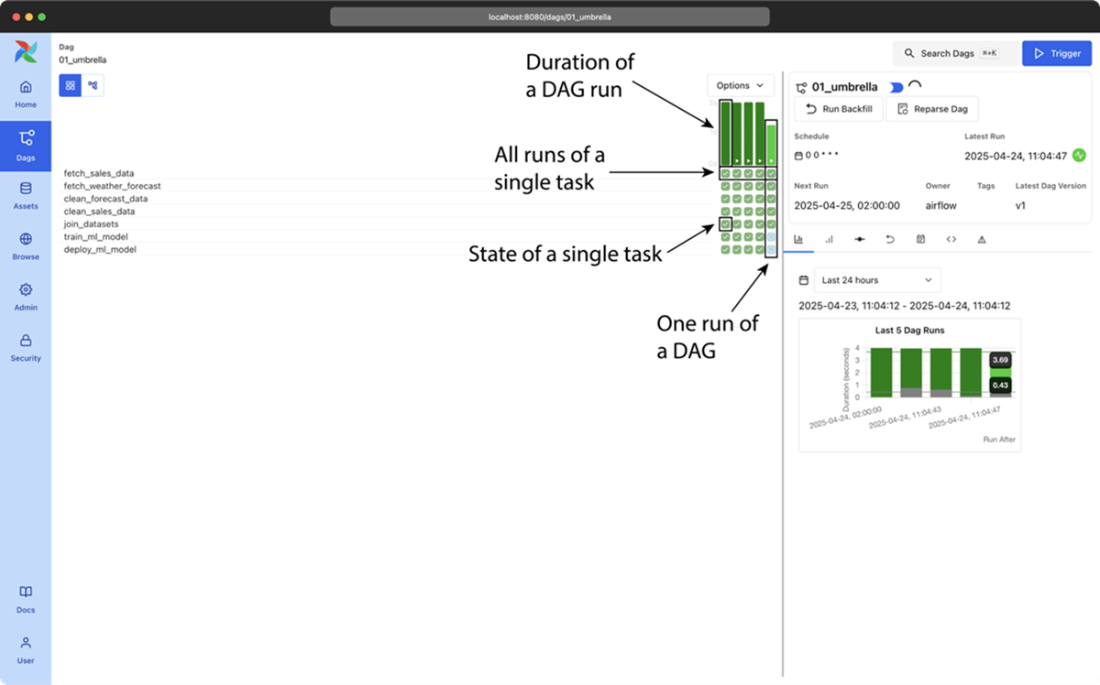
Summary
- Directed Acyclic Graphs (DAGs) are a visual tool used to represent data workflows in data processing pipelines. A node in a DAG denote the task to be performed, and edges define the dependencies between them. This is not only visually more understandable but also aids in better representation, easier debugging + rerunning, and making use of parallelism compared to single monolithic scripts.
- In Airflow, DAGs are defined using Python files. Airflow 3.0 introduced the option of using other languages. In this book we will focus on Python. These scripts outline the order of task execution and their interdependencies. Airflow parses these files to construct and understand the DAG's structure, enabling task orchestration and scheduling.
- Although many workflow managers have been developed over the years for executing graphs of tasks, Airflow has several key features that makes it uniquely suited for implementing efficient, batch-oriented data pipelines.
- Airflow excels as a workflow orchestration tool due to its intuitive design, scheduling capabilities, and extensible framework. It provides a rich user interface for monitoring and managing tasks in data processing workflows.
- Airflow is comprised of five key components:
- DAG Processor: Reads and parses the DAGs and stores the resulting serialized version of these DAGs in the Metastore for use by (among others) the scheduler
- Scheduler: Reads the DAGs parsed by the DAG Processor, determines if their schedule intervals have elapsed, and queues their tasks for execution.
- Worker: Execute the tasks assigned to them by the scheduler.
- Triggerer: It handles the execution of deferred tasks, which are waiting for external events or conditions.
- API Server: Among other things, presents a user interface for visualizing and monitoring the DAGs and their execution status. The API Server also acts as the interface between all Airflow components
- Airflow enables the setting of a schedule for each DAG, specifying when the pipeline should be executed. In addition, Airflow’s built-in mechanisms are able to manage task failures, automatically.
- Airflow is well-suited for batch-oriented data pipelines, offering sophisticated scheduling options that enable regular, incremental data processing jobs. On the other hand, Airflow is not the right choice for streaming workloads or for implementing highly dynamic pipelines where DAG structure changes from one day to the other.
FAQ
What is Apache Airflow and what problem does it solve?
Airflow is an open-source workflow orchestrator for building, scheduling, and monitoring data pipelines. It coordinates work across systems as a DAG of tasks, making it ideal for batch-oriented, data-driven processes such as ingestion, transformation, and model training.
What is a DAG in Airflow, and why must it be acyclic?
A DAG (Directed Acyclic Graph) models a pipeline as tasks (nodes) with dependency edges. “Acyclic” prevents circular dependencies that would deadlock execution (for example, task A waiting on task B while B waits on A).
Why use a graph-based pipeline instead of a single sequential script?
- Clarity: Dependencies are explicit and visual.
- Parallelism: Independent branches can run concurrently.
- Resilience: Rerun only failed tasks and their downstream dependents.
- Maintainability: Smaller, modular tasks are easier to test and evolve.
How does Airflow execute a DAG under the hood?
- DAG Processor parses DAG files and stores metadata in the metastore (via the API server).
- Scheduler evaluates schedules and task dependencies, queues ready tasks.
- Triggerer manages async/deferred tasks that wait on external conditions.
- Workers execute queued tasks and report results back to the metastore.
What are the main Airflow components and their roles?
- API Server: Web UI and API; gateway to the metastore.
- DAG Processor: Parses/serializes DAGs.
- Scheduler: Decides when DAGs run and which tasks are ready.
- Workers: Execute tasks in parallel.
- Triggerer: Handles asynchronous (deferred) task wake-ups.
How are pipelines defined in Airflow?
Pipelines are defined as Python code in DAG files that declare tasks, dependencies, and metadata (such as schedule). Airflow also supports dynamic patterns (e.g., creating tasks or DAGs from configuration), and newer versions add multi-language options, though Python remains primary.
How does Airflow integrate with external systems?
Because tasks are Python-based, Airflow can run virtually any Python-accessible operation. A rich ecosystem of provider packages offers out-of-the-box operators and hooks for databases, big data platforms, and cloud services.
How does scheduling, incremental loading, and backfilling work?
- Scheduling: Use simple intervals (hourly/daily/weekly) or Cron-like expressions.
- Incremental runs: Each DAG run corresponds to a discrete time window, letting you process only the data delta for that interval.
- Backfilling: Run past intervals to create or recompute historical datasets when code or logic changes.
How do you monitor pipelines and handle failures in Airflow?
- Web UI: Overview of DAGs, graph view for structure, and grid view for historical and current runs.
- Retries: Configurable automatic retries with delays.
- Debugging: Inspect task logs; clear task states to selectively rerun failed portions.
When is Airflow a good fit—and when isn’t it?
- Great fit: Time- or event-driven batch workflows; rich integrations; applying software engineering best practices; easy backfills; open-source and production-proven.
- Not ideal: Real-time streaming/event-by-event processing; teams without coding expertise; cases requiring built-in data lineage/versioning (needs complementary tools).
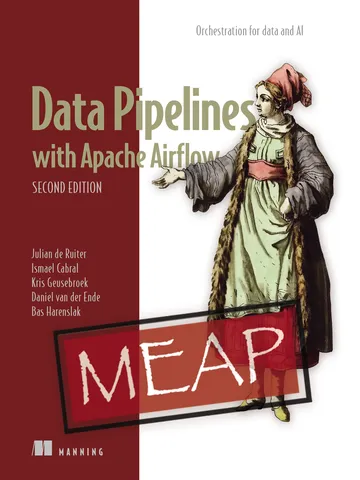 Data Pipelines with Apache Airflow, Second Edition ebook for free
Data Pipelines with Apache Airflow, Second Edition ebook for free